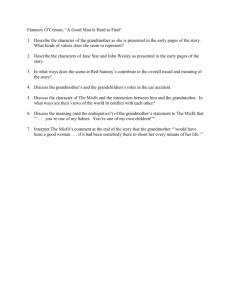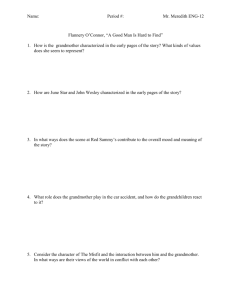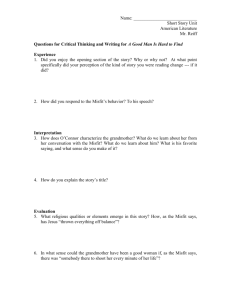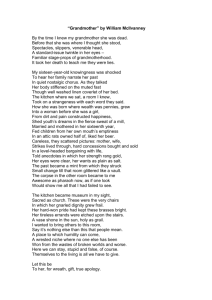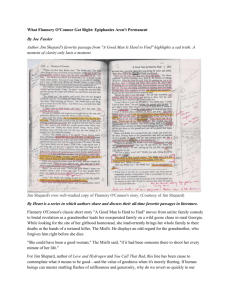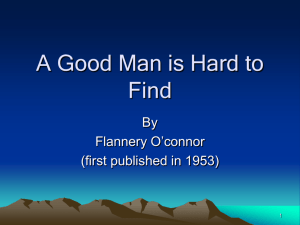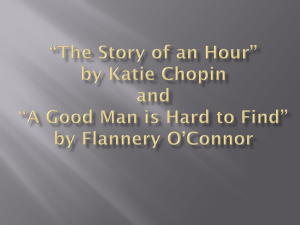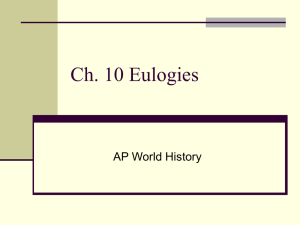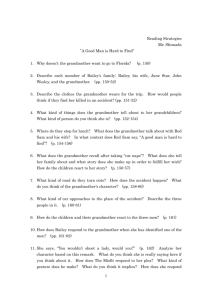A Good Man is Hard to Find
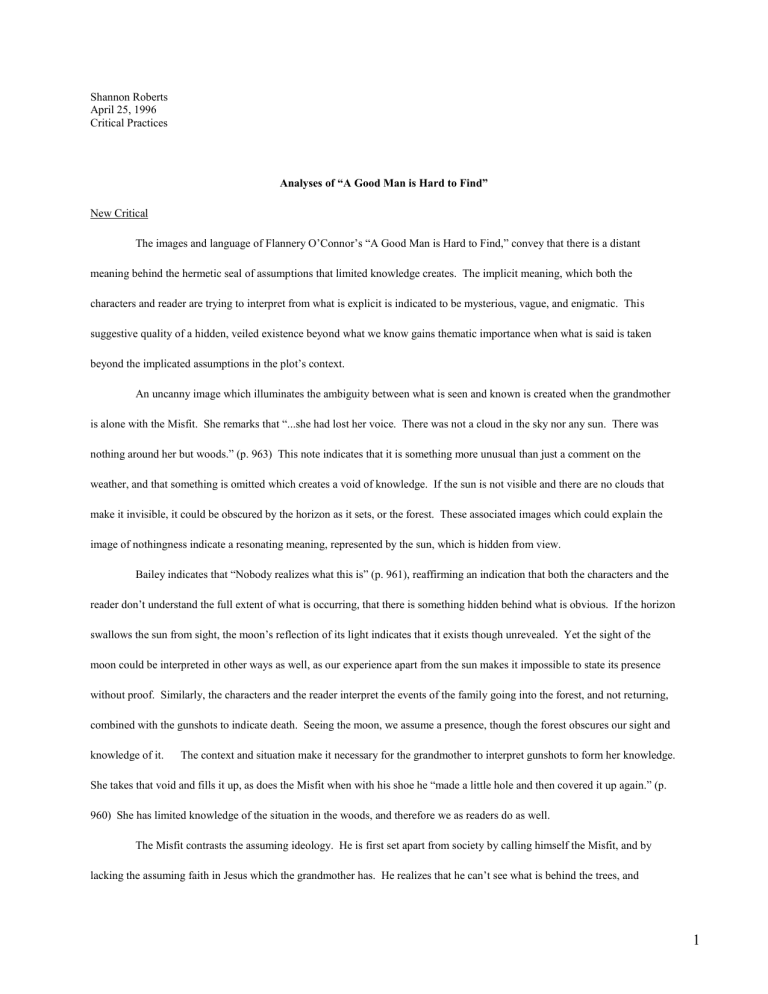
Shannon Roberts
April 25, 1996
Critical Practices
Analyses of “A Good Man is Hard to Find”
New Critical
The images and language of Flannery O’Connor’s “A Good Man is Hard to Find,” convey that there is a distant meaning behind the hermetic seal of assumptions that limited knowledge creates. The implicit meaning, which both the characters and reader are trying to interpret from what is explicit is indicated to be mysterious, vague, and enigmatic. This suggestive quality of a hidden, veiled existence beyond what we know gains thematic importance when what is said is taken beyond the implicated assumptions in the plot’s context.
An uncanny image which illuminates the ambiguity between what is seen and known is created when the grandmother is alone with the Misfit. She remarks that “...she had lost her voice. There was not a cloud in the sky nor any sun. There was nothing around her but woods.” (p. 963) This note indicates that it is something more unusual than just a comment on the weather, and that something is omitted which creates a void of knowledge. If the sun is not visible and there are no clouds that make it invisible, it could be obscured by the horizon as it sets, or the forest. These associated images which could explain the image of nothingness indicate a resonating meaning, represented by the sun, which is hidden from view.
Bailey indicates that “Nobody realizes what this is” (p. 961), reaffirming an indication that both the characters and the reader don’t understand the full extent of what is occurring, that there is something hidden behind what is obvious. If the horizon swallows the sun from sight, the moon’s reflection of its light indicates that it exists though unrevealed. Yet the sight of the moon could be interpreted in other ways as well, as our experience apart from the sun makes it impossible to state its presence without proof. Similarly, the characters and the reader interpret the events of the family going into the forest, and not returning, combined with the gunshots to indicate death. Seeing the moon, we assume a presence, though the forest obscures our sight and knowledge of it. The context and situation make it necessary for the grandmother to interpret gunshots to form her knowledge.
She takes that void and fills it up, as does the Misfit when with his shoe he “made a little hole and then covered it up again.” (p.
960) She has limited knowledge of the situation in the woods, and therefore we as readers do as well.
The Misfit contrasts the assuming ideology. He is first set apart from society by calling himself the Misfit, and by lacking the assuming faith in Jesus which the grandmother has. He realizes that he can’t see what is behind the trees, and
1
therefore decides not to form his knowledge on “papers” that establish his guilt, or which tell about a death on the cross. In his doubt, he is described perfectly by his father, who says, “its some that can live their whole life out without asking about it and it’s others has to know why it is, and this boy is one of the latters.” (p. 961) He is not willing to just accept the assuming decision of
“Authority,” which tells him the absolute of what exists behind the trees, if he can’t see it. On the other end of the spectrum, the grandmother has faith in the death or sun behind the trees, as she had faith in her faulty memory, and in an assumption that the family would return alive.
“A Good Man is Hard to Find,” indicates a secret, unrevealed existence which is concealed by the context of the characters, and the limited knowledge of the reader. It opens a decisive division between those who interpret reflections of the mystery through faith, and those who doubt, and thus refuse to conclude anything from what they cannot experience. The realm of faith and belief are vividly described in the enigmatic invisibility of the sun or clouds. The familiarity of the sun makes its existence believable though there is no proof for that belief, just as the belief in cause and effect makes all but the doubtful believe that the gunshots indicate death.
Historical
Flannery O’Connor’s story, “A Good Man is Hard to Find,” distinctively breaks with the Southern conventional writing that romanticizes events and emphasizes the importance of Southern ideals. O’Connor’s break, which has less direct meaning in its random events, fits in with other trends of its time period, such as abstraction, which was becoming a dominant form for art in
America. Instead of a romanticized linkage of people to their roots, “A Good Man is Hard to Find,” shows people at odds with the history of their surroundings as well as their personal histories.
The grandmother, who seems to be the most concerned for events of the past, recognizes how unconnected everyone is to their country and history. When John Wesley, bored with Georgia, dull in comparison to comic books, wants to go through it
“fast so we won’t have to look at it much,” the grandmother replies that if she were a little boy, she “wouldn’t talk about [her] native state that way.” (p. 955) She has respect for her heritage and thus differs from her indifferent family, who are more concerned with the ironically non-existent future. Because she tells stories from the prime of her life, she is connected to the past, while the other characters are completely distant from the history that has created their present situation.
In the grandmother’s account of Mr. Teagarden, the man who courted her and then became wealthy with Coca-Cola stock, she creates an alternate history for herself. Then she is posited in whatever unknown history did occur, when they drink
2
Coca-Cola, and the relations of the two histories come into contact. Yet this loose capturing of past events does little to explain any of the characters’ present positions. It is as if they are thrown from a void into a situation of glued-together relationships with no historical foundation. With few links to their histories, the characters are thus alienated within chance occurrences as they venture away from the familiarity of their city.
The distance of the story from an idealist stationing of the individual within a well-formed representational context of history makes its abstraction in meaning even more apparent. Even the motivation for returning to the past becomes faulty and a venture of futility when the grandmother wants to see a house from her past. In realizing her mistake, she is violently distanced from the coherent history that she valorized earlier, and creates a fatal situation of alienation from both past and future. In “A
Good Man is Hard to Find,” memory becomes a vague, precarious bridge to history which alienates the individual from meaningful ways to respond to their present situation.
------------------------------------------------------------------------------
Of these methods, the New Critical method works best in evaluating the synthesized parts and how they relate to the complex set-up of the story. Any close reading that relates different aspects of the plot helps in understanding. However, the
New Critical method does not take into context what different references may mean to the story(such as the word “nigger,” or the allusion to “Gone with the Wind), or look into reasons that the author created it as they did. Also, it does not expand the story culturally to relate different aspects of the past, nor does it show the story’s present thematic relevance. With an emphasis on form, it investigates that aspect thoroughly, but in total seclusion from other literature, art and events which surround it, some of the meaning is flattened.
The Historical criticisms of Hendin and Muller, which have different aspects combined here, are also both relevant and problematic in what they lack. Hendin’s criticism style makes broad generalizations of what Southern literature should be, only to show how O’Connor split from it. She makes an assumed importance for a conventional romantic view. While this kind of theory does also broaden the scope by revealing the author’s influences and social context of a writer, it creates extensive limits in making a literary imperative. Her theory, in denying a close analysis of what the language and form conveyed, hollowed out any meaning that wasn’t blatant and crushed the story with meanings that she claimed existed without support. She also gave contradictory arguments to support her theory, at one time saying that the characters were symbolic (the grandmother or Misfit representing Christ), and at other times claiming that O’Connor’s characters had no symbolic or mythic function. (Hendin, p.
3
153) These specific problems of one critic reveal other holes in historical criticism which can destroy a story’s breath by fitting it into a social/historical/contextual box.
Muller’s approach, of fitting O’Connor within a certain type, the grotesque, creates an order to explain how the story functions comparitively. However, by focusing mainly on the genre, it falls short by narrowing the characters’ meanings and complex functions. The reference to other artists illuminates its place within certain thematic contexts, but detracts from
O’Connor’s singularity. By connecting the text’s thematic capabilities to other artists, Muller ignores alternate themes which would detract from his focus on the grotesque. Yet it does find the grotesque’s categorical function as comic through other works, and shows a cultural significance of the grotesque being out of harmony with the world. Though these criticisms omit some complexity of multifarious meanings, they are relevant in their interpretive contributions and methods.
4
